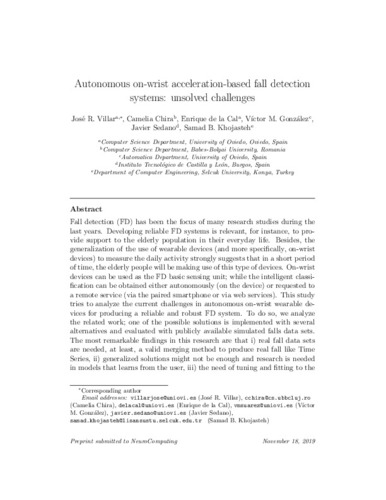Autonomous on-wrist acceleration-based fall detection systems: unsolved challenges
Palabra(s) clave:
Fall detection
Machine Learning
Elderly population
Fecha de publicación:
Versión del editor:
Citación:
Descripción física:
Resumen:
Fall detection (FD) has been the focus of many research studies during the last years. Developing reliable FD systems is relevant, for instance, to pro- vide support to the elderly population in their everyday life. Besides, the generalization of the use of wearable devices (and more specifically, on-wrist devices) to measure the daily activity strongly suggests that in a short period of time, the elderly people will be making use of this type of devices. On-wrist devices can be used as the FD basic sensing unit; while the intelligent classi- fication can be obtained either autonomously (on the device) or requested to a remote service (via the paired smartphone or via web services). This study tries to analyze the current challenges in autonomous on-wrist wearable de- vices for producing a reliable and robust FD system. To do so, we analyze the related work; one of the possible solutions is implemented with several alternatives and evaluated with publicly available simulated falls data sets. The most remarkable findings in this research are that i) real fall data sets are needed, at least, a valid merging method to produce real fall like Time Series, ii) generalized solutions might not be enough and research is needed in models that learns from the user, iii) the need of tuning and fitting to the current user performance, iv) the amount of fall types suggests that hybrid and ensemble approaches might be interesting.
Fall detection (FD) has been the focus of many research studies during the last years. Developing reliable FD systems is relevant, for instance, to pro- vide support to the elderly population in their everyday life. Besides, the generalization of the use of wearable devices (and more specifically, on-wrist devices) to measure the daily activity strongly suggests that in a short period of time, the elderly people will be making use of this type of devices. On-wrist devices can be used as the FD basic sensing unit; while the intelligent classi- fication can be obtained either autonomously (on the device) or requested to a remote service (via the paired smartphone or via web services). This study tries to analyze the current challenges in autonomous on-wrist wearable de- vices for producing a reliable and robust FD system. To do so, we analyze the related work; one of the possible solutions is implemented with several alternatives and evaluated with publicly available simulated falls data sets. The most remarkable findings in this research are that i) real fall data sets are needed, at least, a valid merging method to produce real fall like Time Series, ii) generalized solutions might not be enough and research is needed in models that learns from the user, iii) the need of tuning and fitting to the current user performance, iv) the amount of fall types suggests that hybrid and ensemble approaches might be interesting.
ISSN:
Patrocinado por:
This research has been funded by the Spanish Ministry of Science and Innovation, under projects MINECO-TIN2014-56967-R and MINECO-TIN2017- 84804-R, and by the Grant FCGRUPIN-IDI/2018/000226 project from the Asturias Regional Government.
Colecciones
- Artículos [36339]
- Informática [805]
- Investigaciones y Documentos OpenAIRE [7989]
Ficheros en el ítem





